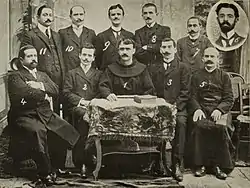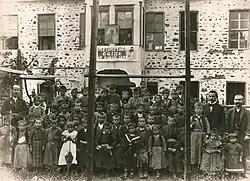Congress of Manastir
The Congress of Manastir (Albanian: Kongresi i Manastirit) was an academic conference held in the city of Manastir (now Bitola) from November 14 to 22, 1908, with the goal of standardizing the Albanian alphabet. November 22 is now a commemorative day in Albania, Kosovo and North Macedonia, as well as among the Albanian diaspora, known as Alphabet Day (Albanian: Dita e Alfabetit).[1][2] Prior to the Congress, the Albanian language was represented by a combination of six or more[3] distinct alphabets, plus a number of sub-variants.[4]

Participants

Row 2: Rrok Berisha, Bajo Topulli, Thoma Avrami, Leonidha Naçi, Sotir Peçi, Shefqet Frashëri, Luigj Gurakuqi, Shahin Kolonja, Akil Efthim Korça, Zenel Poda.
Row 3: Nyz'het Vrioni, Dhimitër Mole, Gjergj Qiriazi, Gjergj Fishta, Mid'hat Frashëri, Dom Nikoll Kaçorri, Dom Ndre Mjeda, Fehim Zavalani.
Row 4: Refik Toptani, Çerçiz Topulli, Mihal Grameno, Friend of Çerçiz Topulli, Member of Manastir Club. Notes: Missing in the photo are the following delegates: Hil Mosi, Grigor Cilka, Hafëz Ibrahimi, Emin Beu, Rauf Beu, Selaudin Prizreni. Names in italic are non-delegates.
The congress was held by the Union Association (Albanian language: Bashkimi) literary society at the house of Fehim Zavalani,[5] which served as the headquarters of the union. The participants of the congress were prominent figures of the cultural and political life from Albanian-inhabited territories in the Balkans, as well as throughout the Albanian diaspora. There were fifty delegates, representing twenty-three Albanian-inhabited cities, towns, and cultural and patriotic associations of whom thirty-two had voting rights in the congress, and eighteen were observers. Below is the list of the participants with the right to vote:[5]
- Sami Pojani
- Zenel Glina
- Leonidha Naçi
- Simon Shuteriqi
- Dhimitër Buda
- Azis Starova
- Adham Shkaba
- Mati Logoreci
- Rrok Berisha Gjakova
- Bajo Topulli
- Grigor Cilka
- Sotir Peçi
- Shefqet Frashëri
- Luigj Gurakuqi
- Shahin Kolonja
- Ahil Eftim Korça
- Hilë Mosi
- Nyz'het Vrioni
- Dhimitër Mole
- Gjergj Qiriazi
- At Gjergj Fishta
- Midhat Frashëri
- Nikoll Kaçorri
- Ndre Mjeda
- Fehim Zavalani
- Refik Toptani
- Çerçiz Topulli
- Mihal Grameno
- Parashqevi Qiriazi
- Havez Ibrahimi
- Rauf Beu
- Selahedin Beu
Proceedings

The speeches of the first two days with regard to the alphabet were general in character, and helped to create the atmosphere in which to carry out the serious work. The representatives understood the importance of unity, regardless which alphabet was chosen. Gjergj Fishta, who praised the development of the Bashkimi alphabet, declared: “I have not come here to defend any one of the alphabets, but I have come here to unite with you and adopt that alphabet which the Congress decides upon as most useful for uplifting the people”. The audience was deeply moved by Fishta. Hodja Ibrahim Effendi, a Muslim clergyman, rushed to Fishta and embraced him with tears in his eyes.[6]
At the beginning of the Congress, the delegates elected a commission consisting of eleven members (four Muslims, four Orthodox and three Catholics) to make a decision before the other delegates arrived.[7] Gjergj Fishta was elected chairman of the commission, Parashqevi Qiriazi chairwoman and Mit'hat Frashëri its vice-chairman. Luigj Gurakuqi became the secretary of the commission while the other five members of the commission were Bajo Topulli, Ndre Mjeda, Shahin Kolonja, Gjergj Qiriazi and Sotir Peçi. Mit'hat Frashëri was also elected chairman of the congress. The delegates took a besa to accept the decision of the committee. The committee deliberated on the question of a common alphabet for three successive days.[6] They promised, through said besa, that nothing would be known before the ultimate decision.
However, the Congress was unable to choose one single alphabet and instead opted for a compromise solution, using both the Istanbul and Bashkimi alphabets, but with some changes to reduce the differences between them. Usage of the alphabet of Istanbul declined rapidly and it became obsolete over the following years as Albania declared its independence.[6] The Bashkimi alphabet is the predecessor of the official alphabet for the Albanian language in use today. Gjergj Fishta noted that German had two written scripts to those disappointed, as here there not one alphabet was chosen, but two. After some discussion, the decision for the use of both the Bashkimi and Istanbul alphabets was accepted by all the delegates. It was also agreed to have every local Albanian authority report to the Union Association, monthly, about developments in their areas. Another agreement resulted in another congress in Ioannina on July 10, 1910.[6]

On November 20, when the congress was coming to an end, Hodja Vildan, Fazil Pasha and Colonel Riza, three members of the Albanian community of Istanbul, arrived. They were to attend the congress and later advise smaller, similar Albanian societies that operated throughout Albania. At first, the three members sought to protect the writing of Albanian with the use of an Ottoman Turkish alphabet. However, Hodja Vildan nullified his concerns. He denounced Sultan Abdul Hamid and defended the importance of unity among Albanians for self-determination and national spirit. Vildan argued that they had a right to use a Latin script, and that this would be a ‘tool’ for progress. He did not take the same position on the direction of writing and matters of religion, however. Said ideas continued to be defended by him in the other places the three members visited.[8]
Legacy

The adoption of a Latin character-based Albanian alphabet was considered an important step for Albanian unification.[8][9][10][11] Some Albanian Muslims and clerics, preferring an Arabic-based alphabet, expressed their opposition towards the Latin script due to concerns that it would undermine ties with the Muslim world.[8][9][10] The situation was also alarming for the Ottoman government, as the Albanians were the largest Muslim community in the European part of the empire, apart from the population of Istanbul. The Albanian national movement was regarded as proof that others also felt a relationship to the nation, not just Christians, and that Islam alone could not keep Ottoman Muslims united.
As a result, the Ottoman Empire organised a congress in Debar in 1909, with the intention that Albanians formally declare themselves as Ottomans, promising to defend their territorial sovereignty and adopting an Arabic-based alphabet.[11] They faced strong opposition from nationally minded Albanians, and the Albanian element took total control of the proceedings.[8] While the congress was progressing, members of the CUP in Tirana orchestrated a demonstration, criticising the adoption of a Latin-based alphabet to the local branch of the Union Association. Talat Bey, the interior minister, claimed that the Albanian population supported the use of the Ottoman Turkish alphabet, and not a Latin-based one. The Union Association did not stop the demonstration, instead organizing a congress with 120 attendees in Elbasan.[10]
Due to the alphabet matter and other Young Turk policies, relations among Albanian elites, nationalists, and Ottoman authorities broke down.[11][12] Though at first Albanian nationalist clubs were not curtailed, the demands for political, cultural, and linguistic rights eventually made the Ottomans adopt measures to repress Albanian nationalism, which resulted in two Albanian revolts (1910 and 1912) towards the end of Ottoman rule.[13][14][15]
The Congress of Manastir represents one of the most important events for Albanians,[16] and the most important after the establishment the League of Prizren, not only because of the decisions made, but also because those decisions were to be legally implemented by the Ottoman authorities.[17] In 2008, festivities were organized in Bitola, Tirana and Pristina to celebrate the centenary of the congress. In all schools in Albania, Kosovo and Albanian-majority areas in North Macedonia, the first school hour was dedicated to honouring the Congress and teaching students about it.
References
- Në Maqedoni festohet Dita e Alfabetit [Alphabet Day celebrated in Macedonia] (in Albanian), portalb.mk, November 22, 2012, archived from the original on September 27, 2013, retrieved September 24, 2013
- The message of the Prime Minister of the Republic of Kosovo, Hashim Thaci on the event if the 103rd anniversary of the session of the Congress of Manastir on November 14, 1908, Kosovo Prime Minister's Office, November 2011, retrieved September 24, 2013
- "Perse u zgjodhen dy alfabete" [Why two alphabets were chosen]. Materiale e Dokumente. Studime Filologjike (in Albanian). No. 4. Tirana: Akademia e Shkencave e RPSSH, Instituti i Gjuhesise dhe i Letersise. 1988. pp. 149–159. ISSN 0563-5780
Partial publication of the memo of Gjergj Qiriazi to the Austro-Hungarian consulate in Manastir, dated May 25, 1909, 20 pages - Frances Trix (1997), "Alphabet conflict in the Balkans: Albanian and the Congress of Monastir", International Journal of the Sociology of Language, 128: 1–24, doi:10.1515/ijsl.1997.128.1, ISSN 0165-2516, S2CID 143944248
- "14 November 1908, the day of the Congress of Manastir". Albania News. November 14, 2019. Retrieved November 22, 2019.
- Gawrych 2006, p. 165
- Entangled Histories of the Balkans – Volume One: National Ideologies and Language Policies. June 13, 2013. p. 504. ISBN 9789004250765.
- Skendi 1967, pp. 370–378
- Duijzings 2002, p. 163.
- Gawrych 2006, p. 182.
- Nezir-Akmese 2005, p. 96.
- Saunders 2011, p. 97.
- Nezir-Akmese 2005, p. 97.
- Poulton 1995, p. 66.
- ShawShaw 1977, p. 288.
- "Six successful years of SEEU". South Eastern European University. Archived from the original on May 27, 2008. Retrieved November 20, 2008.
- Mustafa, Avzi (March 19, 2014), Kongresi i dytë i Manastirit [Second Congress of Monastir] (in Albanian), Dielli,
Kongresi i parë i Manastirit, pas Lidhjes së Prizrenit, ishte ngjarja më e madhe e popullit shqiptar, që u hapi rrugën jo vetëm të kërkesave legjitime të shqiptarëve, por që edhe ato kërkesa të realizohen në mënyrë legale dhe të jenë të lejuara nga qeveria e Sulltanit përmes rrugës parlamentare. translated
First Congress of Monastir, after the League of Prizren, was the biggest event for the Albanian people, which not only opened the path to the legitimate demands of the Albanians, but those demands to come implemented pretty soon in a legal way by the Sultan's government through parliamentary channels
Sources
- Duijzings, Gerlachlus (2002). "Religion and the politics of 'Albanianism': Naim Frasheri's Bektashi writings". In Schwanders-Sievers, Stephanie; Fischer, Bernd J. (eds.). Albanian Identities: Myth and History. Bloomington: Indiana University Press. pp. 60–69. ISBN 9780253341891.
- Gawrych, George (2006). The Crescent and the Eagle: Ottoman rule, Islam and the Albanians, 1874–1913. London: IB Tauris. ISBN 9781845112875.
- Lloshi, Xhevat (2008). Rreth Alfabetit te Shqipes [About the Albanian Alphabet]. Logos. ISBN 9789989582684.
- Nezir-Akmese, Handan (2005). The Birth of Modern Turkey: The Ottoman Military and the March to WWI. London: IB Tauris. ISBN 9781850437970.
- Osmani, Tomor (1999). "Historia e alfabetit" [History of the Alphabet]. Udha e shkronjave shqipe [The Pathway of the Albanian Letters] (in Albanian). pp. 461–496.
- Poulton, Hugh (1995). Who are the Macedonians?. Bloomington: Indiana University Press. ISBN 9781850652380.
- Saunders, Robert A. (2011). Ethnopolitics in Cyberspace: The Internet, Minority Nationalism, and the Web of Identity. Lanham: Lexington Books. ISBN 9780739141946.
- Shaw, Stanford J.; Shaw, Ezel Kural (1977). History of the Ottoman Empire and Modern Turkey: Volume 2, Reform, Revolution, and Republic: The Rise of Modern Turkey 1808-1975. Cambridge: Cambridge University Press. ISBN 9780521291668.
- Skendi, Stavro (1967). The Albanian national awakening. Princeton: Princeton University Press. ISBN 9781400847761.